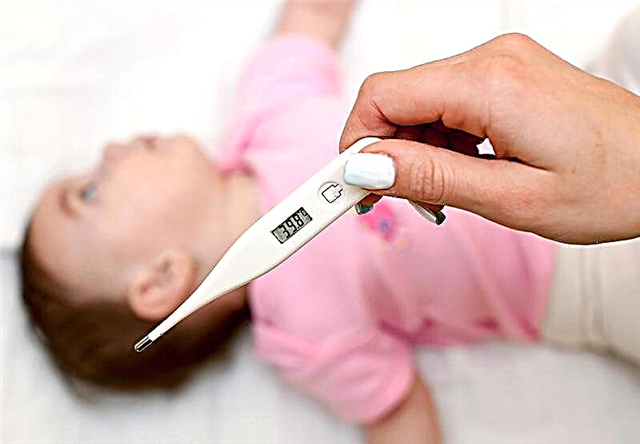
Cedex is a popular antibiotic of the cephalosporin group. It is often prescribed to children, since a suspension is one of the forms of such a medicine. So that the drug does not cause undesirable negative phenomena and helps to cope with the causative agent of the infection, you should find out before starting treatment when it can be given to the child and what doses of such a drug are allowed in childhood.
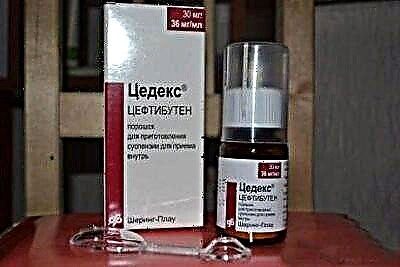
Release form
"Cedex" in the form of a suspension is sold not in liquid, but in dry form. This medicine is a yellow powder that smells like cherries. It is placed in a 30 ml glass bottle in an amount of 8.3 grams. The bottle cap is protected from accidental opening by a child, and on top of the bottle there is a plastic cup marked "28 ml", which is required to dilute the powder.
After mixing with water, a light yellow homogeneous liquid is obtained, which has a sweet taste and a characteristic cherry aroma. Additionally, the box contains a measuring double-sided transparent plastic spoon. On the one hand, it is round and holds 1.25 ml of suspension (45 mg of active ingredient). On the other hand, such a spoon is elongated and holds 5 ml of medicine or 180 mg. It also has two marks - 2.5 ml and 3.75 ml, which correspond to 90 mg and 135 mg of the active substance.
In addition to the liquid form, there are also Zedex capsules containing 400 mg of the active substance. They can be assigned to children over 10 years old if their weight is more than 45 kg.
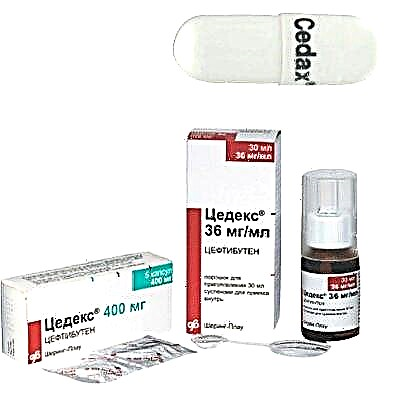
Composition
The main component of Cedex is called ceftibutene and is in the form of a dihydrate powder. Its amount in 1 gram of dry preparation is 144 mg, and after mixing with water, the dosage of such an antibacterial compound is 36 mg per milliliter. The inactive components of the drug are sodium benzoate, silicon dioxide and xanthan gum.
The preparation also contains simethicone, titanium dioxide and polysorbate 80, and in order to make the finished suspension have a pleasant taste, sucrose and cherry flavor are added to the powder.

Operating principle
"Cedex" represents the third generation of cephalosporin antibiotics, therefore it has a very wide antimicrobial spectrum of influence on harmful microorganisms. Its mechanism of action is called bactericidal, since ceftibutene inhibits the formation of cell walls, as a result of which microbes die.
Reception of "Zedex" is fatal for hemophilic rods, Neisseria, Escherichia, Klebsiella, pneumococci, Proteus, Moraxella and many other microorganisms. However, some types of streptococci and staphylococci are resistant to the drug.


The suspension also usually does not work if the disease is caused by listeria, pseudomonas, enterococci and some other pathogens noted in the instructions for the drug.
Indications
The drug is prescribed for infections, the causative agent of which is sensitive to the action of ceftibuten. The suspension is in demand when:
- sinusitis;
- otitis media;
- pharyngitis;
- bronchitis;
- pneumonia;
- tonsillitis;
- gastroenteritis;
- enteritis;
- cystitis;
- pyelitis;
- urethritis.
At what age is it assigned?
The use of the Tsedex suspension is permitted from the age of six months. It is impossible to give the drug to babies in the first months of life, since there is no reliable data on the safety of the drug for such small patients.
Children over 6 months old should be prescribed medication by a doctor.
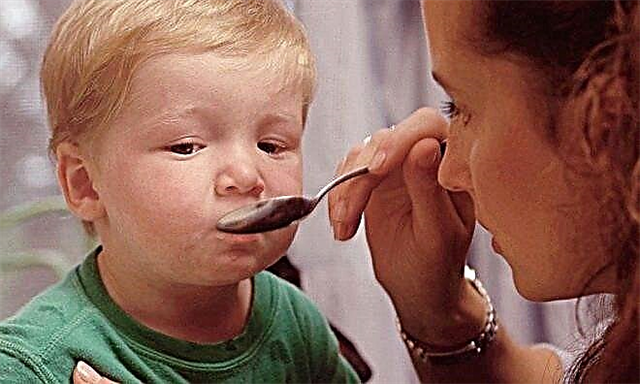
Contraindications
"Cedex" is not prescribed if the child is hypersensitive to its ingredients (both to ceftibuten and to inactive compounds) or to other cephalosporin drugs. Since the powder contains sucrose, this form of "Cedex" cannot be used for congenital disorders of carbohydrate metabolism. Caution in the treatment of the suspension is required by children with allergies to penicillins, renal failure and diseases of the gastrointestinal tract.

Side effects
A child receiving Cedex may develop:
- nausea;
- headache;
- diarrhea;
- vomiting;
- dizziness;
- stomach pain;
- allergic rash;
- drowsiness and other side symptoms.


If, after one or more doses of the suspension, any complaints and discomforts occur, it is recommended to consult a doctor and choose another treatment.
Instructions for use
How to prepare a suspension?
To dilute the powder, you need to take clean water and pour it into the measuring cap that is added to the bottle. After filling the cap with water up to the mark “28 ml”, it is necessary to pour this amount of liquid into the bottle. However, you should not pour out all the water at once - it is best to add the liquid in portions and stir actively each time.

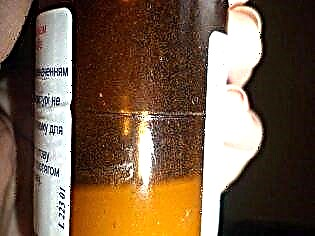
In order for all the ingredients of the preparation to be evenly distributed, the bottle of syrup must also be shaken before each dose of Cedex.
What dosage should be given to the child?
To determine the right amount of suspension for a particular small patient, you need to know his weight. According to the information in the instructions, a child should receive 9 mg of ceftibuten per day for every kilogram of his body weight. In milliliters, this will be 0.25 ml of suspension per 1 kg of baby's weight. For example, if a child weighs 12 kg, he is given 3 ml of suspension (0.25x12) per day, of which the little one will receive 108 mg of the active ingredient.
The maximum allowable daily dosage of "Tsedex" in childhood is 400 mg. This amount of antibiotic is contained in 11.1 ml of suspension and corresponds to an approximate weight of a child of 45 kg. If the medication is prescribed to a teenager who weighs more, the daily dose should not exceed 400 mg.
Before or after meals?
For most diseases, Cedex is taken once a day. In order for the suspension to be as effective as possible and its active component to quickly enter the bloodstream, and then to the infected tissues, it is not recommended to combine the use of Cedex and meals. It is best to take the drug 1-2 hours before meals.
If the child has just eaten, it is better to postpone taking the medication and give the baby a suspension after 1-2 hours.
How long to take?
The duration of the course of treatment is influenced by the disease for which "Cedex" is prescribed. Most often, the medication is prescribed for 5-10 days. If the cause of the disease is streptococcus pyogenic, the drug should be taken for at least 10 days.
It is impossible to stop therapy before the end of the period prescribed by the doctor, since in this case the bacteria may become resistant to the drug, and the infection will remain untreated and after a while its symptoms will resume.

Overdose
If a child accidentally drinks more suspension than the doctor prescribed based on his body weight, it can lead to nausea, headache and other side effects. The medicine is not toxic, but in case of an overdose, gastric lavage is recommended. If the general condition of the child deteriorates, a doctor should be examined.
Interaction with other drugs
"Cedex" can be used with many other drugs. Studies have shown that the suspension is normally compatible with antacid or theophylline treatment.

Terms of sale
Cedex, like other antibacterial drugs, is a prescription drug. Before buying such a suspension for a child, you need to consult a doctor and get a written prescription from him. The average price of one bottle of powder is 540 rubles.

Storage conditions
Keep the powder in a sealed bottle at home in a dry place where the temperature does not exceed the 25 degrees Celsius mark. Such storage is possible throughout the shelf life marked on the package (it is 2 years).
After mixing with water, the medicine should be stored in the refrigerator for no longer than 14 days. If more than two weeks have passed after the preparation of the suspension, the medication should be discarded, even if it has not been taken in full.

Reviews
On the use of "Cedex" in children, they respond mostly well. The advantages of the drug include its liquid form, fast action and pleasant taste. According to the parents, taking such an antibiotic helped to cope with angina, bronchitis, otitis media and other infections. Side effects, judging by the reviews, the medication provokes extremely rarely. The disadvantages of the suspension include only its high cost, so mothers are often interested in cheaper analogues.

What to replace?
Tsedex has no analogues in terms of the active substance, therefore, if necessary, replace such an antibiotic with another medicine, the doctor will prescribe another drug from the group of cephalosporins, which belongs to the third generation. This could be:
- "Pancef". This preparation contains cefixime in granules. He, like "Tsedeks", is allowed from the age of six months. After dilution with water, an orange suspension is obtained from the granules.
- "Suprax"... The action of this drug is also provided by cefixime. It is most convenient for children to give such a drug in granules, from which a strawberry suspension is prepared. This remedy is also prescribed for patients over 6 months old.
- "Cefotaxime". This antibiotic is produced only in injectable form, but can be used from birth. It works quickly and can help fight off serious infections.
- Ceftriaxone. This drug is also presented only in an injectable form and is allowed even for newborns. Such a medicine effectively cope with pneumonia, salmonellosis, peritonitis, sepsis and other dangerous diseases.
If you are allergic to cephalosporins, the doctor may replace Cedex with an antibiotic that belongs to a different group, for example, macrolide preparations Macropen, Azithromycin, Vilprafen or Sumamed.
However, it is impossible to give such medicines without consulting a doctor, because they have a different mechanism of action and have their own peculiarities of use.
Doctor Komarovsky will tell you which antibiotic is best for bronchitis in the next video.

